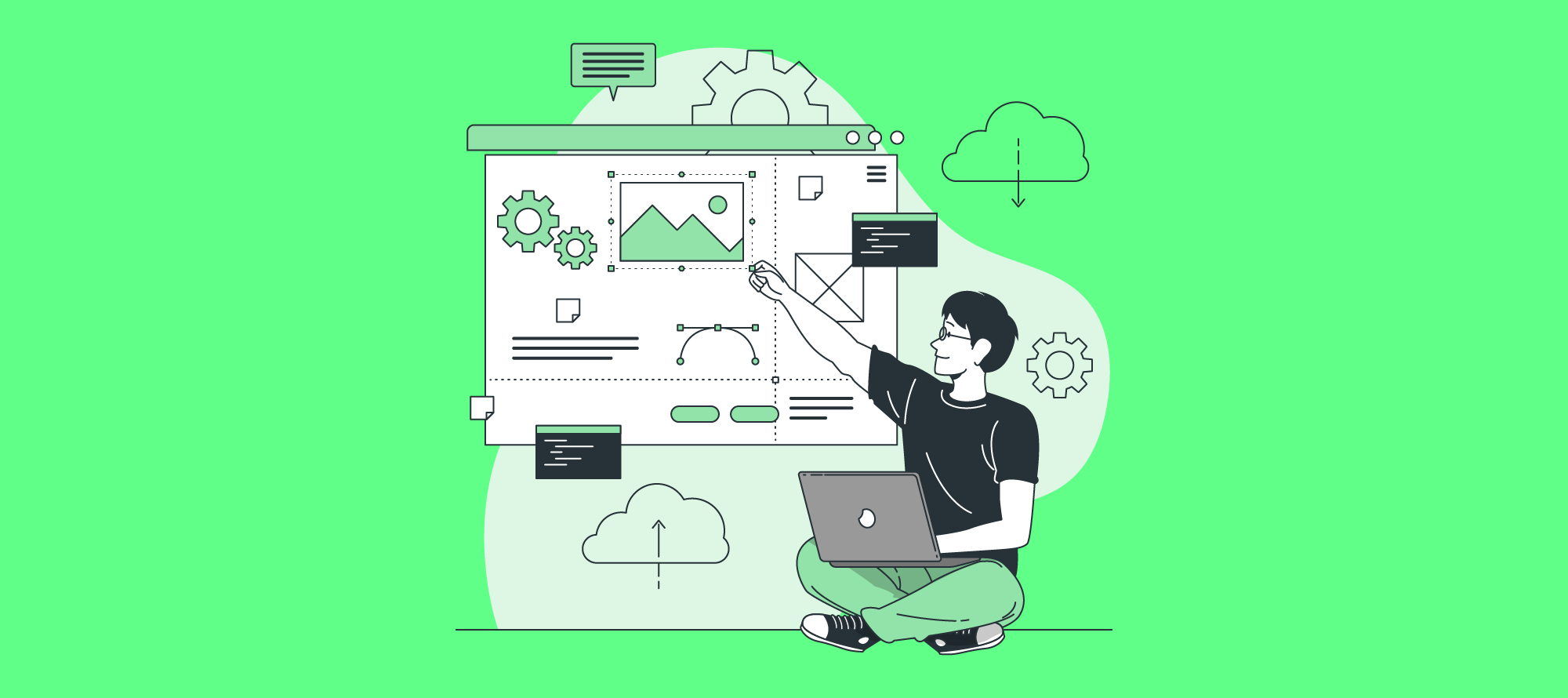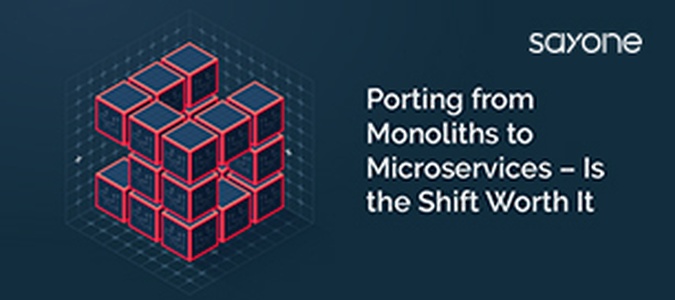Should you migrate from monolith to microservices architecture

Share This Article
Porting from Monoliths to Microservices
Table of Contents
Subscribe to Our Blog
We're committed to your privacy. SayOne uses the information you provide to us to contact you about our relevant content, products, and services. check out our privacy policy.
It has been only a few years since microservices architecture has become made its appearance. However, the architecture is gaining popularity because of the advantages it offers in terms of scalability and flexibility of the systems. Many successful enterprises such as Amazon and Netflix have successfully shifted to microservices architecture only to become market leaders in innovative products. The question that many businesses and enterprises ask is ‘should we shift to the microservices architecture from monolithic systems’. We attempt to answer the question in this article.
Monolithic Architecture

A monolith is built as a single package for different devices such as a tablet/desktop/mobile. RDBMS is used as the data source. The single-tiered application package has all the different components such as the ones for authorization, presentation, the business logic, database layer, application integration, and the notification modules combined into a single package.
Download Ebook for FREE "How to choose the best microservices vendor and trim the cost"
A typical example of a monolith eCommerce application package would work as follows: it would authorize the customer, take the product order, check the inventory, authorize payment and ship the products that were ordered.
A monolith is the best resort when you launch a project. It is simple to develop and test and testing and deployment are equally simple. Horizontal scaling of a monolith involves running multiple copies behind a load balancer. If you want to hit the ground running, building a monolith is the way to go.
Disadvantages of a Monolithic Application
The disadvantages of a monolith are mainly because of the size of the package include difficulty in maintaining the package because of its size. This adds to its complexity and therefore changes cannot be implemented quickly.
Read our blog : Advantages of Microservices Architecture, Disadvantages of Microservices Architecture
Scaling becomes an issue because different modules may have different resource requirements. A monolith is less reliable because a single bug can bring down a whole process. It is difficult for a monolith to adapt to newer technologies such as changes in languages or technologies and maintaining a monolith is a costly affair.
Microservices Architecture

Microservices refers to many compartmentalized smaller services that make up a whole big application. Microservices represents a range of capabilities, from the simple to the very complex and from the small to the very big.
In a microservices application, many smaller application modules exist and work alongside as parts of a larger software application to accomplish what would be normally carried out by a monolith.
How is the Microservices Architecture Laid Out
Each of the modules in the microservices architecture is designed to support one single business goal. The loosely coupled modules use well-defined interfaces using which they communicate with one another.
Read our blog: The 5 Best Microservices Technologies List
Every microservice in the package has its own database which provides the loose coupling. Each service uses the type of database that best suits the service’s function. However, there is some duplication of data in this architecture.
- A microservices eCommerce application would be organized thus:
- Authorization Service — Authorizes customer
- Order Service — Order processing
- Catalog Service — Product inventory checking and managing
- Cart Service — Manage the user cart
- Payment Service — Manage and authorize payments
- Shipping Service — Ship ordered products to customers
Advantages of Microservices Architecture
There are many advantages that microservices architecture offers to an organization. However, read on for the most prominent of these benefits:
- The microservices architecture is well-suited for the deployment of large and complex applications and affords faster testing of the modules because each one is small. Each of the modules so tested can be deployed independently.
- As far as managing and organizing the different development teams is concerned, you can engage one team for one service. This makes it easy and efficient as each team has the liberty to develop and scale their module independently of the other team. They understand the requirements better and each team can use the technology of their choice for the module. Moreover, the modules can be deployed faster.
- Fault location and isolation is easy. Likewise, any fault affects only a single service while others continue to function as usual.
- There is no necessity for any of the individual services to commit long-term to any technology stack. Each service can pick a new technology at the time of modification or whenever deemed necessary.
Microservices and Scalability
The microservices are independently scalable. This is perhaps the most marked advantage of adopting microservices architecture for your enterprise/organization. Generally, you decide to have a monolithic application in place when you are yet to know what the needs of the project are. This leads to overspending on the capacity that you have no idea about.
Read our blog "Building Microservices Application Using Spring Boot & Cloud"
In monolithic applications, many large organizations were sitting on unused computing resources that were sitting idle most of the time. They ended paying for unused servers most of the time and paying up for the spike that never occurred.
However, it is also true that every application is vulnerable to demand spikes that may occur at any time. Scaling monolithic applications can take place only on a coarse-grained level. With microservices, the infrastructure becomes more elastic.
Microservices also help to break the anti-patterns by adding or reducing capacity according to the demand. Enterprises can work along with their business teams to scale up when there is extra demand and ramp it down when the demand decreases.
Read our blog : How to find the best microservices development company
Together with benefits from the public cloud systems, resources that are not used by one group in the organization can be used by another group.
An Example – API driven Ecommerce Microservices Application
The recommendation engine, order processing, search, cart inventory and accounts administration can be split into different modules/microservices. Here, it is quite likely that the accounts administration may not require as many resources as the order processing systems. With a monolith, an entire application has to be scaled up to accommodate increased order demands. If order processing functionality is turned into a microservice, it can be scaled independently as and when the demand occurs.
Microservices and Flexibility
Using microservices as the software development protocol leads to responsive, flexible and sustainable systems. The ability to install lightweight data collectors, or simply applications that collect performance metrics, at the service level help developers monitor the development, implementation, and functioning of the services more efficiently.
Each microservice is designed to perform one single function extremely well and this improves flexibility multifold. Any number of extra functions can be added or subtracted as required in real-time.
Are you looking to shift to microservices architecture? Call us today.
Development practices for building microservices have instilled the advantages of code reusability or using the same code for multiple purposes. This reduces the expenses related to the time, budget and resources involved in developing code. It allows for quicker development and safer because one service is insulated from the other.
Microservices and Resilience
With the entire application being decentralized, each service acts as a separate entity. There is a minimal impact when there is a failure in such a system. Even when another system is down for maintenance, the users will not notice the difference.
Microservices and the Right tools
With each service using the most suited language and technology, using microservices architecture frees your organization from being tied up to a single vendor. The flexibility to use the right tool for the right task emerges.
What you should keep in mind before building Microservices for your Business/Organization
The question is when to start with microservices. If you are building the first version of your business application, developing it using the microservices architecture will delay the process considerably. However, if you already have the application running, but are looking to scale up the operations, shifting to microservices would be ideal.
Read our blog : How Kubernetes Works to Support Microservices Architecture
Microservices will function better in the longer term. However, setting it up is a complicated process. Different teams developing the different services have to work in coordination to implement the different use cases for the various services.
Deployment of microservices is also complex in that the memory usage will be high while implementing the different services.
Microservices is not always the answer

With far less overhead for deployment and less coordination with different teams, the effort for initiating a change is also very less. During development, once the monolith application is loaded into the developer’s machine, they get a full feel of the application, unlike the microservices case. Only when many services are loaded is the experience complete. Therefore, it is the responsibility of each team to decide which approach is best for the organization in the current situation.
Read our blog : Why Business leaders should care about Microservices
An organization can split a monolith into microservices when the application becomes too big for updating or maintaining efficiently. Another aspect that can trigger the change is thinking about whether the service can sustain itself on the customer end. Thinking about whether a microservice would offer better customer service and usability is the best point at which you can decide which way to go.
Can your Business manage with Microservices?
Some organizational caveats are listed below in case you want to implement microservices in your organization.
Be ready for Rapid App Deployment and Resource Provisioning
With continuous delivery and incremental development, the implementation of microservices keeps the staff on its toes. They should be capable of continuously provisioning resources to keep pace with the microservices. You cannot take a month to provision a server or extra memory that is required. You will run into more trouble than you can ask for.
Read our blog : Advantages of Microservices Architecture, Disadvantages of Microservices Architecture
Robust Monitoring Methodologies is a Must
You should have robust methods of monitoring the different teams that will simultaneously work with different technologies and platforms. Managing the infrastructure well is important because if a service goes down unattended, you may not be able to track down the origin of other problems that may ensue.
Embrace DevOps Culture
Incorporating DevOps culture helps you work efficiently in cross-functional teams. This makes everyone responsible for the provisioning of services as well as their failure.
Be Ready for Failure
When implementing microservices, be ready for failure. Multiple failures can happen simultaneously: slow service, system downtime, and unexpected responses. In the face of multiple failures occurring simultaneously, the service should still run at a degraded level without crashing the system.
Conclusion
Using the microservices approach can improve the resilience of your application and quicken your time to market. However, when breaking down services to a fine-grained level, many complications can arise. We have given you a fair glimpse of these in the above passages. Go for microservices architecture when you are ready.
Are you looking to scale up your operations? Book a free consultation at SayOne Technologies!
Share This Article
Subscribe to Our Blog
We're committed to your privacy. SayOne uses the information you provide to us to contact you about our relevant content, products, and services. check out our privacy policy.




